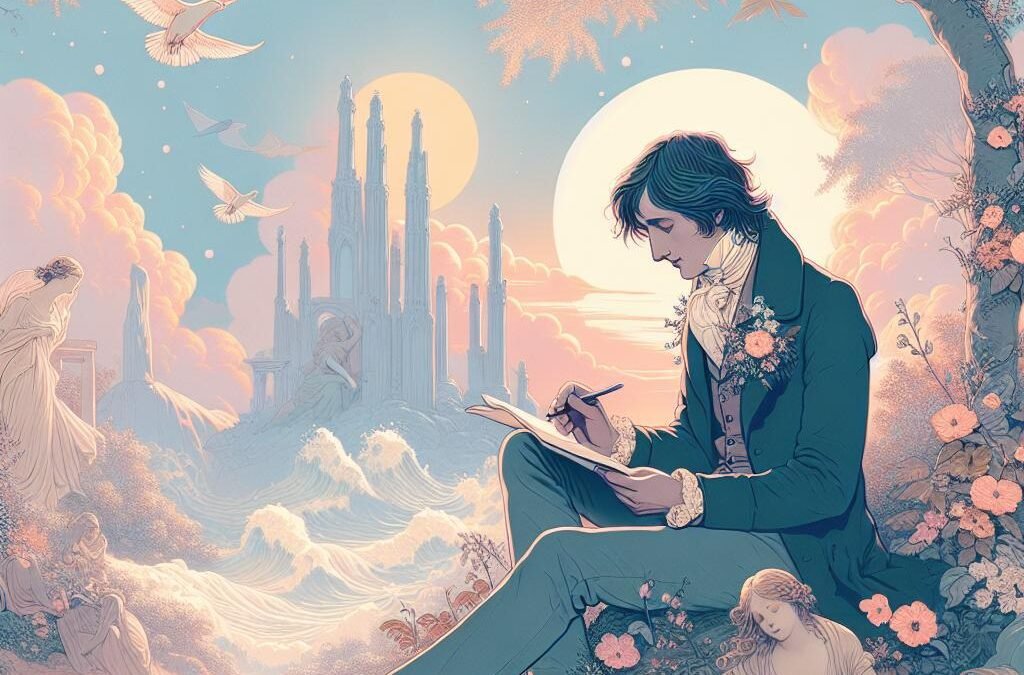John Keats poems unfold against a landscape shaken by revolution and restless after the Enlightenment’s waning star. Imagination, once curbed, now gallops unfettered through English verse. In this tumultuous dawn, Romantic bards (Wordsworth, Coleridge, Byron, Shelley) strive with tempest and ether, their “lyric selves” plucking meaning from the gossamer web of ecstasy and ruin. Keats, youngest among them, treads paths shadowed by urban squalor and industrial clangor. Regency streets thrum with class unease, the machinations of surveillance, and the stir of political unrest, all echoing in the chamber where the poet crafts his “sensations sweet.” The ephemeral beauty of “soft incense” and “fume of poppies” rises amid anxiety’s smog, and myth knots itself with science both wondrous and dire. Such is the amphibian soil in which Keats, son of modest lineage, takes root. Educated beneath Charles Cowden Clarke’s guiding hand, he drinks Homer and Spenser at dusk, while by day his steady surgeon’s hand bears witness to mortality’s claim. In the heady circle of Leigh Hunt and Benjamin Haydon, friendly rivalries ignite his ambition while bolstering the spirit that weathered criticism and nursed devotion to Fanny Brawne, the muse entwined with his fleeting years. Among his letters, a soul’s battle—negative capability shimmering beside “soul-making”—ripples as steadily as the nightingale’s song, an unbodied joy hovering amid corporeal decline.
Historical and Poetic Terrain: The Realm of John Keats Poems
In the Regency’s bristling air, John Keats poems bear wounds and wonders of a society betwixt era and experiment. Government sanction and timorous newspapers wage covert war against radical ink; the anxieties of Jacobin tumult linger, as penmen ponder mechanization’s cost and the uncertainty of genius uncoupled from status. Keats’s verses, marked not by moral prescription but by sensual engagement, question the very marrow of existence. His distinguishing power springs from immersion: neither stoic nor preacher, Keats moves among “songs for the faery queen,” Grecian urns, shadowed lovers, and Autumn’s full-throated splendor, breathing upon language until mortality’s chill warms in beauty’s embrace. The poet figures forth nature as catalyst and confidant: a riverbank for dreaming, an orchard for lament.
Odes and sonnets conjure worlds where myth and sensation are never contained, where “ambiguities without irritable reaching” triumph over certainty. This refusal of didactic chains fires a longing for both transience and transformation, as the verse circles possibilities rather than conclusions, a doorway swung wide upon time’s uncertain wind. The self, vulnerable among city and copse, coalesces through music and metamorphosis: a nightingale’s dissolving song, a lover’s smile tilted toward separation, an Autumn bough burdened with swift decay. Amid these cadences, Keats rebuffs the telos of ancient instruction, finding in sense and sorrow the clearest oracle the modern age permits. Alongside canonical giants from the Romantic epoch, Keats’s artistry is explored in celebration of English poetic craft here.
Themes Interwoven: Mortality, Beauty, and Transformation
No curtain shields the spirit in Keats’s theater: impermanence steps forth, a bold player clad in the hues of autumn and shaded with the pallor of sighs. Flowers, ripe fruit, and “withered leaves” speak of joy poised on the precipice of loss, while “To Autumn” and “Ode to a Nightingale” stage the dance where abundance strains against cessation, and melody contends with silence fathoms deep. Death’s shadow does not banish beauty but magnifies the moment—enchantment grows brighter before twilight’s hush. Within every “beaker full of the warm south” vibrates the tension of vanishing, yet pleasure blooms fiercely as petals about to fall. Thus beauty draws near to philosophy, beckoning the mind to dwell at the threshold where truth flickers and meaning refuses to rest in permanence. In the swirling interplay of “truth and beauty” upon the urn’s steadfast form, Keats locates revelation in incompletion and longing.
Art’s pursuit in John Keats poems rides the boundary of sensation and reflection. Vivid language rolling with “purple-stained mouth” and “country green” superimposes feeling upon thought, as synaesthesia braids melody, color, and perfume into knotted enchantments. The poems inhabit a realm of “liminal” spaces, where sorrow sharpens perception, contradictory emotions coil together, and transcendence announces itself amid the fragile. Melancholy’s keen edge transforms agony, for in “Ode on Melancholy” and the refrain-haunted “La Belle Dame sans Merci” suffering bestows a vital intensity, propelling the soul’s vision to loftier heights. Joy and lamentation, hope and ache, commingle in a single stanza: never static, always quick with possibility.
Nature, Imagination, and the Metamorphosis of the Self
Nature walks no silent path in Keats’s songs: fields, seasons, and boughs become vibrant partners in human drama. The “viewless wings of Poesy” arise from rootedness in vulnerability and sensation’s feast. Poems do not escape into ideal, unpeopled woodland but rather press the boundaries between flesh and fancy, agony and awe. Storm, dew, and birdsong serve as heralds of the imagination’s sovereign ascent, yet never untethered from corporeal trial. In autumn’s fullness and spring’s delicate trembling, the poet finds both the seed of longing and the harvest of understanding, always conjured with the lyric force of Shakespearean vigor.
Resource and muse alike, the natural world emerges as both scene and actor, whispering that beauty draws sustenance from impermanence. Transformation abides at every turning: a nightingale’s immortal chorus flares and fades, a Grecian urn preserves yet withholds its bliss, the mortal heart yearns for endless song and surrenders to silence. Metaphors multiply—nature’s cycle signals psychic flux and the mind’s restless inquiry. Metaphorical invention ensures the poems’ vitality, fusing earth with spirit, sensation with thought in a perpetual exchange worthy of Prospero’s spells.
Psychic struggle churns beneath the odes, wounds transformed into radiant utterance. Keats’s famed “negative capability” finds fullest expression in a willingness to dwell in uncertainty, accepting mystery, error, and doubt as lodestars of poetic creation. This artistry performs a marriage of opposites: substance and shadow, reason and fancy, sorrow and rapture all fuse in tempests of language never content to rest with the counterfeit of certainty.
The Shakespearean interplay between artifice and reality reverberates throughout the canon. In this dance, suffering confers substance and “soul-making” contends with oblivion, as seen in both poems about art and more personal confessions. Love, whether sanctified or unrequited, drives the pen to conjure visions at once visionary and elemental.
Technique and Style: The Music of Language in Keats’s Craft
Keats’s verse inherits the echo of iambic pentameter’s stateliness, yet with a nimble footwork that cleaves and leaps—enjambment and caesura splitting the line, internal rhyme braiding mood through sound, and assonance kindling a bell-like resonance. Each stanza is wrought with the artisan’s care, blending classical symmetry with improvisational fervor. “Heard melodies sweeter,” “soft incense,” “tasting of flora and the country green”—phrases that entwine the senses and invite the reader into the rapture of embodied perception. In this auditory architecture, word and sound entwine so tightly that time itself seems to pause in worship of cadence. Insights on poetic soundscape and historical evolution can be explored through resources like poetic technique analysis by later generations.
Allusion (Shakespearean, Hellenic, folk) floods the works. Greek urns, tragic heroines, Olympian revelers rest in stanzas whose symbolic reach spans centuries. These echoes do not chain the imagery but lend manifold meaning. Interpretations shimmer with the ambiguous, leaving room for mythic grandeur and numinous suggestion. The petrarchal sonnet, the Spenserian stanza, ode’s polyphonic structure—Keats bends classical precedent to his singular genius, making his song anew. Through imagery woven with Shakespearean verve, even the simplest object (a pomegranate, a falling leaf) becomes charged with cosmic import.
Art, both process and record, stands revealed in emblem and paradox. The urn and the nightingale serve as mirrors to time’s fleeting theatre and the yearning of the soul. In this crucible, imagination reigns but never unmixed; Keats’s “negative capability” suspends easy conclusion, forging instead a music wound tight with uncertainty, vision, and the terror of mortality.
Legacy and Influence of John Keats Poems
The afterlife of John Keats poems ascends through centuries, bearing fruit in the hands of modern lyricists and those revering sensitivity and sensory abundance. Comparative analysis with Shelley and explorations of love poetry traditions bear testimony to the continuing pulse of his imagination in English literature. From the attic-laden romances of the Victorian era to new poetic experiments on contemporary soil, Keats haunts the forms of modern verse. His legacy was sharpened anew in Dylan Thomas’s lush phrasings and the tactile bravura of poets frequently celebrated at Romantic Poems.
Across anthologies and academic citadels, through the glass of song and theatre, Keats’s voice persists—the nightingale uncaged, the Grecian urn facing the gaze of modernity unflinching. Essential guides to understanding this lineage may be found through established literary studies in the Poetry Foundation and revered historic sources such as Encyclopedia Britannica. His Shakespearean subtlety and sensual grandeur bind his works to the restless seeking of those who crave transformation through language and revel in the unstable, golden hour when beauty and sorrow conspire.

